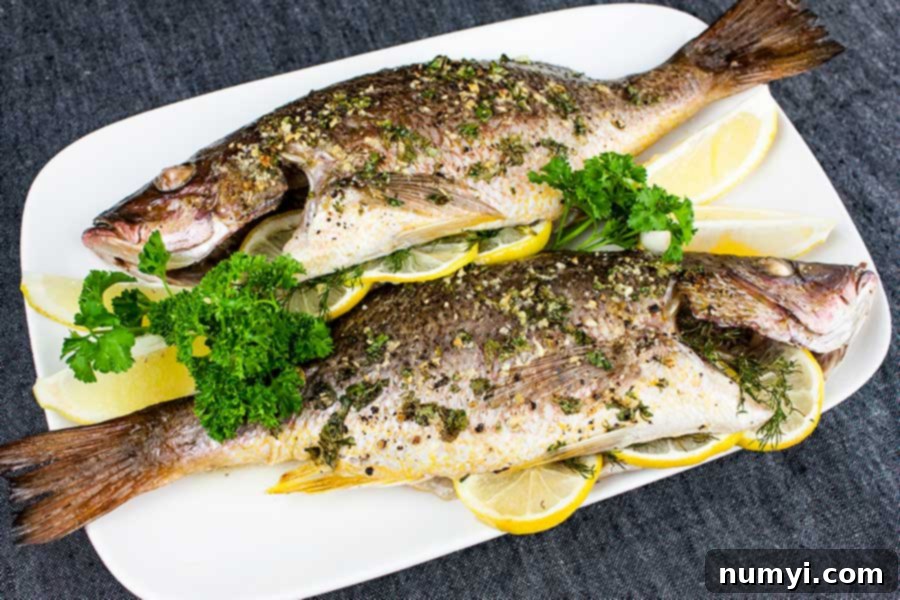Baked Whole Red Snapper: An Easy, Healthy, and Impressive Seafood Dinner
Baked whole Red Snapper is a truly remarkable dish – a perfect blend of heart-healthy nutrition, straightforward preparation, and an elegant presentation that will impress at any dinner party, yet remains simple enough for a weeknight family meal. This stunning fish, seasoned with bright citrus and aromatic herbs, transitions from your kitchen to the dinner table in under an hour, promising a succulent and flavorful experience.
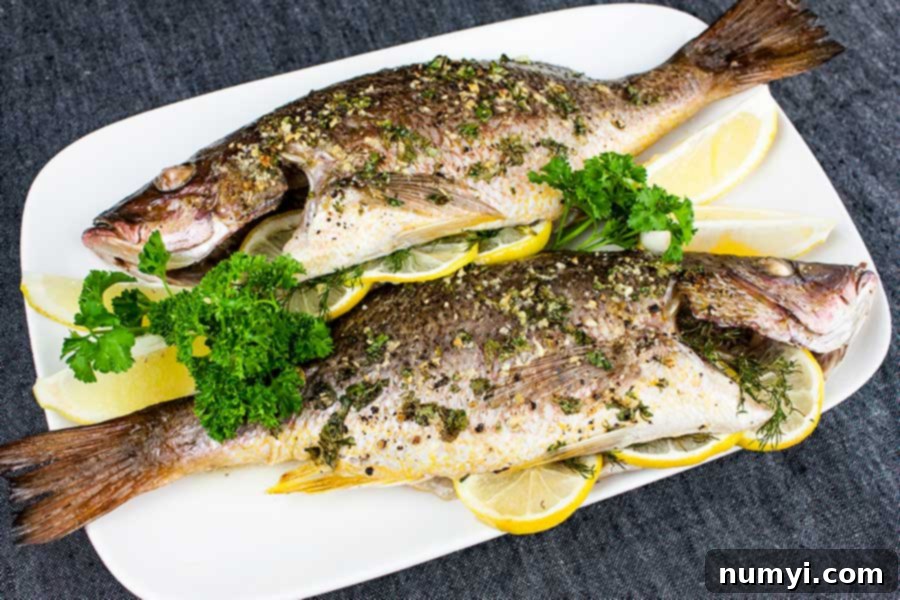
There’s an undeniable charm to serving a whole baked fish. It’s not just a meal; it’s a centerpiece, a conversation starter, and a testament to fresh, wholesome cooking. This red snapper recipe, infused with zesty lemons and fragrant dill, is designed for maximum flavor with minimal fuss, ensuring every bite is perfectly tender and bursting with taste.
Why You Will Love This Recipe
There are countless reasons to adore this baked whole red snapper recipe, but let’s boil it down to the essentials: it’s incredibly easy to make, exceptionally healthy, and utterly delicious. But beyond these core benefits, this dish offers a feast for the senses that goes far beyond simple sustenance.
Visually, serving a whole baked red snapper is nothing short of spectacular. Imagine placing this beautifully stuffed, golden-skinned fish, garnished with fresh herbs and lemon slices, right in the center of your dinner table. The inevitable “oohs and aahs” from your guests are guaranteed. We truly eat with our eyes first, and this striking presentation immediately sets an anticipation for a tantalizing culinary experience.
And the promise is always delivered. Each bite reveals perfectly tender, moist, and flaky fish, infused with the vibrant flavors of citrus and herbs. It’s a dish that feels gourmet but requires minimal culinary skill, making you look like a seasoned chef without all the effort. Red snapper is also a fantastic source of lean protein and essential omega-3 fatty acids, contributing to heart health and overall well-being. So, you can indulge in this flavorful meal knowing you’re nourishing your body.
This versatile dish pairs wonderfully with a variety of sides, allowing you to tailor your meal to any occasion. Consider serving it with a creamy basmati rice risotto for a comforting touch, or a loaded cauliflower mash for a lower-carb option. For a lighter accompaniment, a crisp fresh vegetable salad or even a classic blue cheese wedge salad provides a refreshing contrast, creating a perfectly balanced and unforgettable meal.
What is Red Snapper?
Red snapper is a popular and highly sought-after fish, known for its vibrant red scales and delicate flavor. While the term “red snapper” can refer to several species of fish found across the globe, in the United States, the most commonly encountered variety is Lutjanus campechanus, primarily sourced from the bountiful waters of the Gulf of Mexico, the western Atlantic Ocean, and occasionally the Pacific coast. This fish is a staple in many cuisines due to its appealing texture and taste.
Characterized by its lean, firm, and white flesh, red snapper offers a subtly sweet and remarkably mild flavor. This delicate profile makes it incredibly versatile, as it readily absorbs and enhances the flavors of fresh herbs, spices, and marinades without being overpowered. Unlike some stronger-tasting fish, red snapper’s gentle essence ensures it’s a crowd-pleaser, appealing even to those who might be hesitant about seafood. Its firmness also means it holds up exceptionally well to various cooking methods, from baking and grilling to pan-searing, making it a reliable choice for diverse recipes.
How to Buy Fresh Red Snapper
The success of any fish dish begins with selecting the freshest ingredients, and red snapper is no exception. Knowing what to look for at the fish market or grocery store can make all the difference in the final taste and texture of your meal. Here’s a detailed guide to help you choose the best whole red snapper:
- Eyes: The clearest indicator of freshness is the fish’s eyes. Look for clear, bright, and bulging eyes. They should appear moist, almost wet, as if the fish just came out of the water. Avoid any fish with cloudy, sunken, or dull eyes, as these are sure signs of age.
- Flesh: The snapper’s skin should be firm, shiny, and vibrant in color, reflecting its natural bright red hue. When you gently press the flesh with your finger, it should spring back immediately, indicating good elasticity and freshness. If an indentation remains, the fish is not as fresh as it should be. The surface should also be free of any milky or slimy residue.
- Gills: Lift the gill plate and examine the gills. They should be a bright pink or red color, appearing clean and moist. Avoid fish with brown, grayish, or dry gills, as this suggests the fish has been sitting for too long.
- The “Smell Test”: This is arguably the most crucial test. Fresh fish should smell like the ocean – clean, briny, and fresh. It should never smell overtly “fishy,” ammoniac, or sour. If the odor is strong and unpleasant, trust your instincts and move on to another selection. A truly fresh fish will have a subtle aroma.
Don’t be shy about asking your fishmonger for assistance. A good fishmonger will be happy to answer your questions, help you select the freshest fish, and even prepare it for you (scaling and gutting) if you prefer. While cooking a whole fish might seem intimidating at first glance, once you discover how wonderfully simple it is, you’ll likely find yourself incorporating it into your weekly rotation, enjoying its ease and impressive results.
How To Prepare This Stuffed Whole Red Snapper
Preparing this stuffed whole red snapper is a straightforward process that yields incredibly flavorful results. Follow these steps for a perfectly cooked fish that’s moist on the inside and beautifully crisp on the outside:
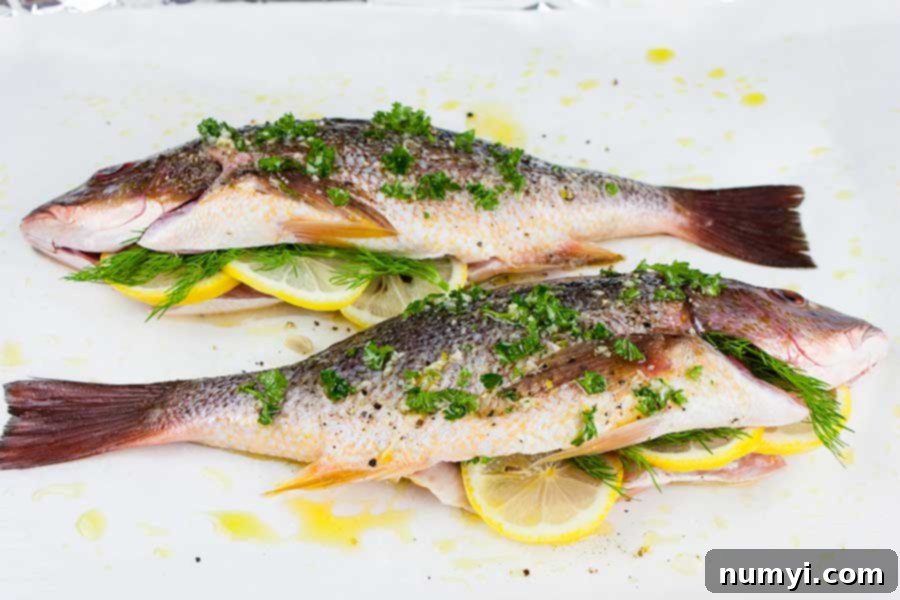
Begin by preheating your oven to a high temperature of 425ºF (220ºC). Roasting at this high heat is key to achieving a beautifully crispy skin while ensuring the fish’s delicate flesh remains incredibly moist and tender.
Next, prepare a large, rimmed baking sheet. Line it first with aluminum foil, then top the foil with a sheet of parchment paper. The foil provides extra protection and makes cleanup even easier, while the parchment paper prevents the fish from sticking to the pan and helps create a lovely crust. Brush one tablespoon of extra virgin olive oil evenly over the parchment paper; this adds another layer of non-stick protection and contributes to the overall flavor of the fish.
In a small bowl, whisk together the remaining extra virgin olive oil, white wine vinegar, minced garlic, and fresh parsley. This mixture will serve as both an internal stuffing binder and an external glaze, infusing the fish with bright, aromatic flavors.
Using paper towels, carefully pat the whole red snapper dry, both inside and out. This crucial step helps achieve that desirable crispy skin during baking. Once patted dry, lay the fish gently onto the prepared parchment paper-lined baking sheet. Generously sprinkle kosher salt and freshly ground black pepper evenly over both sides of the fish and inside its cavity. Don’t be shy with the seasoning, as this forms the flavor base.

Now for the stuffing! Carefully spread half of the prepared oil and vinegar mixture inside the fish cavity. This liquid infuses flavor from within. Then, arrange the thinly sliced lemon rounds and fresh dill sprigs inside the cavity. These aromatics will steam gently as the fish bakes, creating a wonderfully fragrant and flavorful interior. Finally, brush the remaining oil and vinegar mixture generously over the top and sides of both fish, ensuring an even coating for a golden finish.
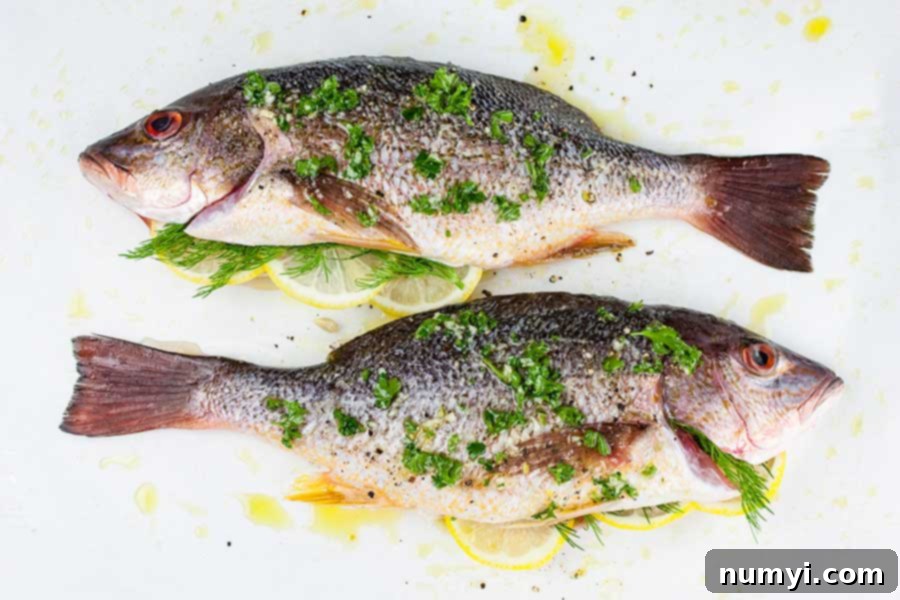
Carefully transfer the baking sheet to the preheated oven. Bake for approximately 25-30 minutes. The exact cooking time will vary depending on the size and thickness of your individual fish. To determine if the fish is perfectly cooked, insert an instant-read thermometer into the thickest part of the flesh (avoiding the bones); it should register an internal temperature of 145°F (63°C). Alternatively, the fish should flake easily with a fork at its thickest point. Overcooking can lead to dry fish, so keep a close eye on it!
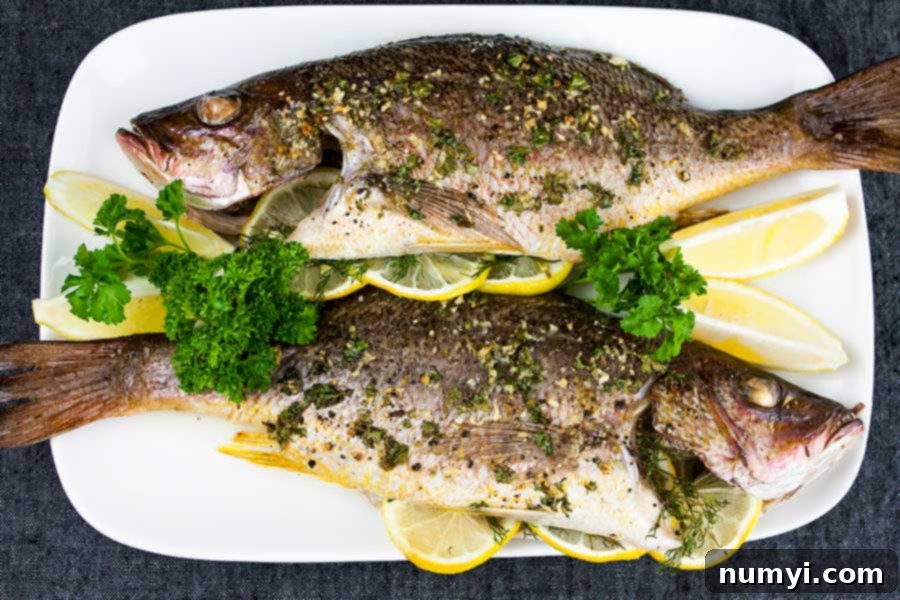
Once baked to perfection, remove the fish from the oven. For an extra burst of fresh flavor, squeeze the remaining lemon juice over the hot fish just before serving. Transfer the beautiful baked whole red snapper to a serving platter, garnish with additional fresh herbs if desired, and present it proudly. See? Roasting a whole fish is ridiculously easy and incredibly rewarding. Don’t hesitate; try this delicious recipe immediately and discover your new favorite way to enjoy seafood!
Tips And Variations
While this recipe for baked whole red snapper is fantastic as is, don’t hesitate to experiment with different flavor profiles and ingredients. Here are some tips and variations to inspire your culinary creativity:
- Herb & Vegetable Stuffings: The cavity of a whole fish is an ideal place to infuse flavor. Instead of just dill and lemon, consider stuffing the fish with a medley of fresh spinach, tender Swiss chard, finely minced garlic, and a generous handful of fresh parsley. You could also add sliced cherry tomatoes, olives, or capers for a Mediterranean twist. The vegetables will steam gently inside, adding moisture and a rich, earthy flavor to the fish.
- Cajun/Creole Twist: For a bold, zesty flavor, create a Cajun or Creole-inspired stuffing. Start with the “holy trinity” of green peppers, onion, and celery, finely diced and sautéed until softened. Mix these with some breadcrumbs, a generous dash of Cajun or Creole seasoning (such as paprika, cayenne pepper, onion powder, garlic powder, and dried thyme), and perhaps a hint of hot sauce. Stuff this mixture into the fish cavity. Serve this vibrant creation with classic dirty rice for a truly authentic and delicious meal.
- Other Fish Substitutions: If fresh red snapper is unavailable, don’t despair! Several other firm, white-fleshed fish make excellent substitutions for baking whole. Good alternatives include grouper, cod, rockfish, branzino, barramundi, or even a smaller whole sea bass. The key is to choose a fish that is scaled and cleaned and has a similar lean, mild profile that can benefit from the aromatic stuffing.
- Scoring the Skin: For an even crispier skin and deeper flavor penetration, use a sharp knife to make a few shallow diagonal slashes (about 1/4 inch deep) across both sides of the fish before seasoning. This also helps the skin to cook more evenly and prevents it from curling.
- Aromatics Underneath: To add even more flavor and prevent sticking, consider arranging a bed of thinly sliced onions, additional lemon slices, and extra fresh dill sprigs directly on the parchment paper before placing the fish on top. These aromatics will gently roast beneath the fish, contributing to a more complex flavor profile and making cleanup even simpler.
- Make a Quick Pan Sauce: While the fish is baking, you can prepare a simple pan sauce. Once the fish is removed from the oven, deglaze the pan with a splash of white wine or chicken broth, scraping up any flavorful bits. Whisk in a knob of butter and a squeeze of fresh lemon juice, then spoon it over the fish just before serving for an added touch of elegance and flavor.
FAQs
While snapper is incredibly versatile and can be prepared in many ways, baking is an excellent method, especially for whole, stuffed snapper like in this recipe. Baking at a high temperature ensures the fish cooks through evenly, resulting in moist flesh and a deliciously crispy skin. For fillets, grilling or pan-searing are also popular and convenient, providing a quick cook time and a beautiful crust, though these methods are not ideal for a stuffed whole fish.
No, it is generally recommended to keep the skin on when cooking whole snapper. The skin acts as a natural protective barrier, helping to retain moisture and flavor in the delicate flesh beneath. Furthermore, when properly seasoned and cooked at a high temperature, the skin becomes wonderfully crispy and develops a rich, savory flavor, adding to the overall enjoyment of the dish. It also contributes to a more appealing visual presentation.
Absolutely! The skin of the snapper, especially when baked or pan-seared, crisps up beautifully and is completely edible. Many find the crispy skin to be a delightful textural contrast to the flaky meat. A light seasoning on the skin enhances its flavor, making it a delicious part of the meal. If you prefer not to eat it, the skin is also very easy to remove after cooking.
Like most whole fish, snapper does contain a central bone structure and smaller pin bones. However, when cooked properly, the flesh of the fish tends to separate very easily from the bones, making it relatively simple to navigate. It’s always a good idea to eat slowly and carefully, especially when serving children, but the flavor and moistness of whole baked fish make it well worth the minor effort.
Red snapper is an excellent choice for a healthy diet. It is a lean source of high-quality protein, essential for muscle building and repair. It’s also rich in Omega-3 fatty acids, which are vital for heart health, brain function, and reducing inflammation. Additionally, red snapper provides important vitamins and minerals such as Vitamin D, selenium, and potassium, all contributing to overall well-being.
The most reliable way to check for doneness in a whole fish is to use an instant-read meat thermometer inserted into the thickest part of the fish, avoiding the bone. The internal temperature should reach 145°F (63°C). Alternatively, you can test by gently flaking the flesh with a fork at its thickest point; if it separates easily and appears opaque throughout, it’s ready. The eyes of a cooked whole fish may also turn white and opaque.
Other Delicious Fish Recipes
If you’ve enjoyed this delightful baked whole red snapper, you’ll be thrilled to discover more fantastic fish recipes that are equally simple to prepare and packed with flavor. Expanding your seafood repertoire is a fantastic way to enjoy healthy, delicious meals any day of the week. Dive into these other popular options:
Crispy Beer Battered Fish
Pan-Seared Salmon Salad with Lemon Dijon Vinaigrette
Ceviche Recipe (Shrimp and Cod)
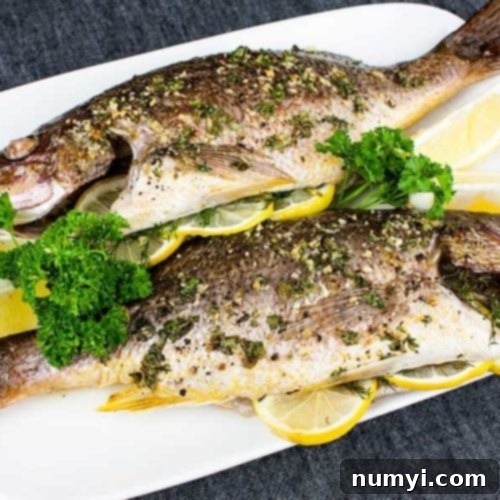
Baked Whole Red Snapper Recipe
Print
Pin
Rate
